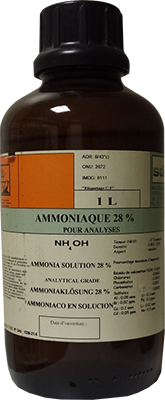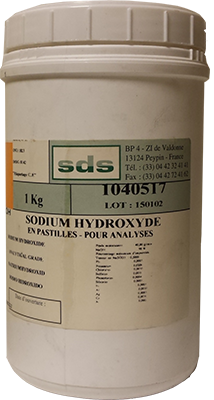The different chemicals
ACIDS AND BASES
Acids
Acids are chemical compounds capable, in solution, of accepting electronic doublets, allowing them to release a proton. If an acid is miscible with water it releases the hydronium ion (H3O+). Pure acids can be found in different forms: solid (citric acid, tartaric acid), liquid (acetic acid, sulfuric acid) or gaseous state (hydrogen halide).
There are two main categories of acids:
- Organic acids: formic acid, acetic acid
- Mineral acids: hydrochloric acid, sulfuric acid

Formic acid
Strong or weak acid?
An acid is called strong or weak depending on the dissociation of the compound in a solvent. A strong acid will totally dissociate whereas a weak acid will only partially dissociate.
Handling:
Pure acids or highly concentrated acids (>1mol/L) must be handled under a fume hood to avoid inhaling possible acid fumes, which are harmful to the respiratory tract. Less concentrated acidic solutions (Since acids are highly corrosive, it is essential to wear personal protection when handling them and to rinse with plenty of water in case of contact with skin, eyes or clothing..

Citric acid

Amoniac
Bases
Unlike acids, bases are chemical species capable of capturing protons once in solution. Bases can also be in solid form (lime, soda) or in liquid form (pyridine).
- Mineral bases: soda, lime
- Organic bases: pyridine, formate

Soude
Handling of basic solutions and safety glasses
Even more so than for acids, wearing safety glasses is compulsory when using basic solutions. In the saponification reaction, a base reacts with a fatty acid. Since the eye is covered with a protective oily film, a drop of a basic solution would cause a saponification reaction that could irreversibly damage the eye.




